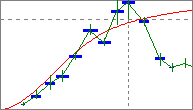

number of points: 30 (input data points)
shifting of groups: 123.19 (increase of distance from group to group)
number of >0-groups: 16
number of 0-groups: 0 (groups without a value-pair (no row))
% overlap of groups: 0 (see variogram options)
max. to observe: 0 (see variogram options)
theoretical variogram: range: 1000 (the theoretical
sill: 2.8 variogram can also
nugget: 0 be displayed as a
type: 60.0 % gaussian column in the table
type: 40.0 % linear as shown below: ytheo)
xmean npairs ytheo ymean yfuzzy_min yfuzzy_max
----------- ----------- ----------- ----------- ----------- -----------
205.734 14 0.430314 0.358571 0.287143 0.701429
324.999 25 0.819329 0.6684 0.5172 1.102
449.098 30 1.26433 0.799 0.594667 1.45167
567.53 46 1.67493 1.67 1.43761 2.29239
691.947 38 2.05413 1.92974 1.75974 2.38526
816.776 45 2.36666 2.65311 2.23533 3.42556
938.201 44 2.61023 2.64136 2.52023 2.89864
1055.59 38 2.80243 2.71553 2.19 3.68395
1180.75 46 2.97655 2.60022 2.23978 3.27804
1305.72 26 3.13219 2.82038 2.42615 3.74346
1424.9 24 3.27203 1.04125 0.91625 1.375
1548.74 29 3.41331 1.32379 1.14966 1.73448
1672.13 14 3.5524 0.707143 0.66 1.09286
1783.23 7 3.67709 0.311429 0.26 0.625714
1925.06 6 3.83605 0.273333 0.273333 0.273333
2088.99 2 4.01966 0.01 0.01 0.01
This is the same information that can be seen in the
variogram window of the kriging window:
The next pages deal with